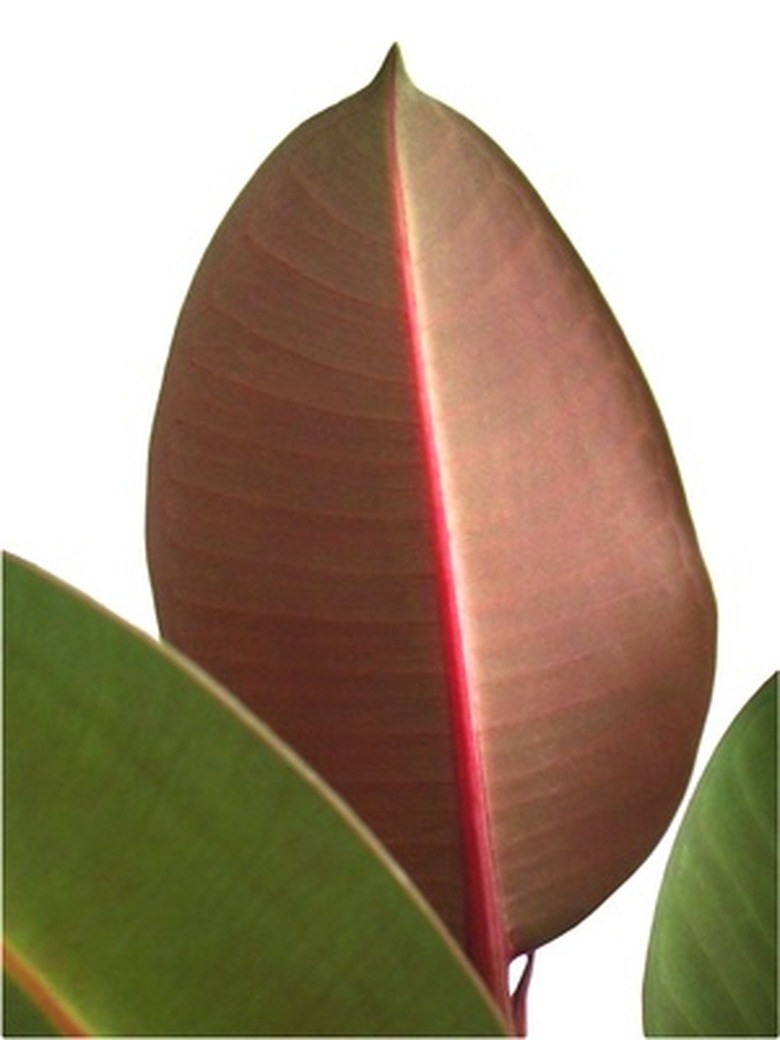Parts Of A Rubber Tree
Rubber tree is a common name for Ficus elastica. It is a member of the fig genus. Rubber tree plants grow 25 to 40 feet tall in most residential landscapes. It is native to the forests of western Asia and in its native setting, it reaches 100 feet high. In cooler climates, people frequently grow the rubber tree plant as an ornamental, indoor container plant.
Foliage
Rubber plant leaves are broadleaf evergreens. Oval leaves alternate on the stems. The blade length ranges from 8 to 12 inches. The leaves have a leathery feel with a glossy appearance. A viscous milky sap fills the stems and leaves. The leaves develop inside a reddish sheath at the tip of the branches. The sheath expands as the leaf grows. When the leaf reaches maturity, it unfurls and the sheath drops off.
- Rubber tree is a common name for Ficus elastica.
- In cooler climates, people frequently grow the rubber tree plant as an ornamental, indoor container plant.
Fruit
The fruit is round and small, generally less than 1/2 inch in length. It is green and not showy. Rubber plant fruit does not attract wildlife other than the fig wasp. Every species of fig has its own species of pollinator wasp and does not need a scent or showy flowers to attract other pollinators.
Trunk
The trunk droops as the tree grows. Prune away secondary trunks early on in the plant's life to give it the best chance to develop a strong structure. The wood of the trunk is weak and susceptible to breaking when subjected to very strong winds. In some instances, the trunk will develop air roots that extend down and anchor the plant into the soil. These aerial roots provide additional support for heavy branches.
- The fruit is round and small, generally less than 1/2 inch in length.
- In some instances, the trunk will develop air roots that extend down and anchor the plant into the soil.
Care Of A Rubber Tree
Locate the rubber tree plant in an area with bright, indirect light or partial sun, which is sun in the morning and shade in the afternoon. This plant needs protection from hot summer sun beating in through the windows. Remove any water that drains into the tray. During the winter, water less often, letting the soil dry out before watering again. Dip a soft cloth in water and wring it out. Mix a small amount of hand soap into the water used to clean the leaves to aid in removing stains. Mix water-soluble fertilizer into the water once every two months when the rubber tree is grown in high light. Watch indoor rubber trees for scale, aphid, mealybug and spider mite infestations. Mist the leaves with a mixture of 3 parts rubbing alcohol and 1 part water if you discover these pests. If roots creep out of the container's bottom, transplant into a larger plant pot.
- Locate the rubber tree plant in an area with bright, indirect light or partial sun, which is sun in the morning and shade in the afternoon.
- Mix water-soluble fertilizer into the water once every two months when the rubber tree is grown in high light.
